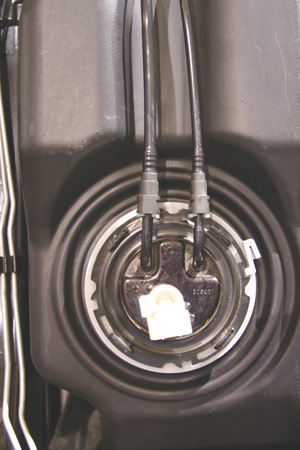All late model engines are equipped with some type of Multiport Fuel Injection (MFI) system. With this setup, a separate fuel injector is provided for each cylinder. The injectors are usually mounted in the intake manifold and spray fuel into the intake ports. On some newer engines, such as VW’s “direct gasoline injection” engines, special high-pressure injectors spray directly into the combustion chamber similar to a diesel engine. Some older engines have a “Throttle Body Injection” (TBI) setup that uses only one or two injectors in a throttle body. Another variation is General Motors’ “Central Point Injection” (CPI) system. Here, a centrally-located “Maxi” injector routes fuel to mechanical poppet valve injectors at each cylinder.
 In a fuel-injected engine, a high-pressure fuel pump (which is usually mounted inside the fuel tank)
In a fuel-injected engine, a high-pressure fuel pump (which is usually mounted inside the fuel tank)
supplies fuel to a common fuel rail on the engine.
Connected to this rail are the fuel injectors, which spray fuel vapor into the engine. Each injector has a solenoid valve at the top that lifts a pintle to open the nozzle. When the solenoid is grounded or energized, the valve is pulled open allowing fuel to spray out of the injector. Fuel pressure is controlled by a spring-loaded fuel pressure regulator valve on the fuel rail, or by a regulator valve at the fuel pump outlet in the case of “returnless” EFI systems.
The Powertrain Control Module (PCM) determines the on-time of each injector pulse to regulate fuel delivery (a longer on-time means more fuel and a richer mixture), and it may vary the speed of the fuel pump to increase fuel flow under load. The PCM uses inputs from the oxygen sensor in the exhaust as well as throttle position, engine speed, load and airflow to control the injectors.
Dirty injectors are a common problem. Injector nozzles can become clogged with fuel varnish over time, causing a loss of engine performance and misfiring. Injectors can also leak fuel, causing an increase in fuel consumption and emissions. An injector failure will result in a dead cylinder and power loss. A shorted injector may rob voltage from the other injectors and cause the engine to stall. Dirty injectors can often be cleaned to restore performance. Fuel cleaning additives help, but the best results are obtained with on-car flushing or off-car cleaning. New injectors are expensive, so a more affordable alternative are aftermarket “remanufactured” injectors.
The fuel pump is probably the most troublesome component in the fuel system. The pump is energized by the PCM through a relay and/or the oil pressure sending unit when the engine is cranked and started. Pressure ratings vary depending on the application, but typically range from 35 to 85 psi. Pump designs also vary and include single or double-vane, roller vane, turbine or gerotor style pumps. Most have a one-way check valve to maintain pressure in the fuel system when the engine is shut off (for easier starting next time).
Fuel pumps can fail for a variety of reasons: old age, loss of voltage or ground at the power relay, wiring connections or pump motor, or bearing damage. Running the fuel tank empty may damage the pump because it relies on fuel for lubrication. Accurate diagnosis is essential to prevent unnecessary pump replacements and returns.
Replacement fuel pumps must have the same pressure rating and flow characteristics of the original, but do not have to be the same type as the original. The pump is usually part of the fuel sending unit and may be replaced separately or as a complete assembly. The fuel inlet strainer sock should also be replaced when the pump is changed.
The fuel tank must be dropped to replace the pump, and the inside should be inspected for dirt or rust that could cause the new pump to fail. A metal fuel tank that is badly corroded inside or is leaking must be replaced. Plastic tanks can also deteriorate with age and may need to be replaced.
An inline fuel filter between the fuel pump and engine protects the injectors from dirt, sediment or rust that gets sucked through the pump. Most newer vehicles do not have a specified replacement interval for changing the fuel filter, but replacing it every two to three years for preventive maintenance is still a good idea. Some “lifetime” fuel filters are mounted inside the tank, and are part of the fuel pump assembly.
The throttle body on the engine regulates airflow into the engine to determine engine speed and power. Idle speed is controlled by a solenoid valve that allows a small amount of air to bypass the throttle plate. Varnish buildup in the idle bypass can cause idle problems and stalling.
Airflow into the throttle is measured by a “mass airflow” (MAF) sensor on most late model fuel injected engines, though some older engines use a vane airflow sensor. Others have no airflow sensor and estimate airflow based on throttle position, engine speed and load. A dirty MAF sensor can cause a lean fuel condition. Cleaning the sensor with aerosol electronics cleaner can often restore normal operation.
Hoses for fuel injection lines must be pressure-rated to withstand the high operating pressure. Low-pressure fuel hose for an older carbureted engine should never be used on a fuel injected engine.













